Introduction
Agriculture has reached a stage where traditional practices cannot provide enough output for the needs of a rising population and many farmers are searching for reliable methods that can give them stability. Climate patterns are changing, natural resources are shrinking and fertile land is limited yet food demand continues to grow without pause. New techniques that combine machines, sensors , data and modern science are being introduced as tools that allow farmers to make better choices in daily work. People with money to invest have started to notice that farming supported by advanced ideas can bring steady income while also helping society so this mixture of social purpose with financial growth is pulling investors closer to agriculture once again.
Key Trends Shaping AgriTech Investments
Connected Agriculture and Digital Monitoring
Devices linked to the internet are now placed in fields to record details of soil moisture weather shifts and crop health and this information guides farmers toward accurate steps. Satellite pictures and digital maps are used to monitor large farms and data storage in cloud systems allows instant sharing with experts.
Precision Farming and AI Driven Insights
Computer programs can read collected data and predict crop problems before they appear and this helps to reduce waste of water or fertiliser. Equipment guided by satellites can place seeds, spray nutrients or water plants in a way that saves resources.
Robotics Automation and Autonomous Machinery
Robots, drones and self-driving tractors are becoming common in areas where labour is short and they perform tasks such as spraying, planting and harvesting without fatigue. In closed spaces such as vertical farms or greenhouses machines create balanced conditions that raise output even in urban regions.
Supply Chain Transparency and Blockchain
Many people who buy food want proof of origin as well as digital records that can trace items from seed to the shop shelf with accuracy. This form of tracking helps sellers maintain trust and makes it easier to solve problems when contamination or errors appear.
Climate Resilience and Sustainability
New irrigation systems are built to save water and less use of chemicals is reducing harm to soil. Governments across many regions are placing programs that support these methods with financial grants and policies that encourage adoption.
Biotech and Crop Innovation
New crop varieties are being created to survive drought pests and changing temperatures which helps farmers reduce risk of loss. Soil treatments, bio fertilisers and micro organisms are introduced to keep ground healthy and productive for longer cycles.
Market Size and Investment Landscape
Money invested in digital farming and related tools has grown quickly in the last decade and research reports suggest that growth will continue with speed across the coming years. In regions such as Asia and Africa governments are encouraging adoption with tax benefits and subsidies which is increasing confidence among investors. Large private funds and venture groups are now placing capital in start ups that design simple tools for small farms while others focus on larger models with wide reach. Although some markets carry higher risks due to lack of infrastructure investors who accept longer return periods may gain rewards that extend beyond direct profit.
Challenges and Risks
Adoption of advanced practices requires heavy spending at the beginning, and many small producers feel reluctant to borrow money because repayment seems uncertain when income is unstable. Rural areas often face poor internet signals and irregular electricity, which blocks continuous use of machines that depend on steady connections. Some farmers prefer traditional approaches because they were taught by earlier generations, and limited training also makes them uncomfortable with modern systems. Another source of doubt comes from questions about who controls the flow of data, since information collected from fields is becoming as valuable as the crops themselves. Weather shocks like floods, heatwaves or storms continue to strike without warning, shaking confidence even among farms that are well prepared, and this mix of risk makes investors hesitate while farmers worry about survival.
Investment Opportunities and Strategies
Start ups that focus on affordable tools for small land holders are attracting attention as their models can expand quickly across many villages. Companies offering farm management software and platforms that connect farmers with buyers are also drawing investment interest where producers of sensor drones and machines are receiving strong backing and seed companies working on resilient crops have become appealing to long term investors. Public and private groups can cooperate to reduce risk by sharing funds for infrastructure and training. Some investors are linking capital with social and environmental targets which can create both financial return and positive impact.
Case Studies and Examples
In India firms are using digital tools and sensors to predict pest attacks and suggest actions and government programs are providing aid for technology adoption. State initiatives are allocating large sums for projects that apply artificial intelligence to farming practices. Countries such as China have introduced national plans to bring digital systems into farming within fixed time frames and these programs are pushing rapid growth of local start ups. Therefore each region has unique approaches yet the overall direction shows steady movement toward modernised agriculture.
Implications for Investors
Risk levels vary between early stage ideas and mature solutions yet those who study carefully may find high value opportunities. Investors are advised to consider both local farming traditions and policy support before committing funds. Solutions that can expand across regions while adapting to different crops will, carry a better chance of success. Measures of impact beyond profit such as water savings or soil health are now included in many contracts since global awareness is shifting toward sustainability. Blended models of finance with a mix of grants, loans and equity are helping reduce pressure on farmers while keeping projects attractive for backers.
Conclusion
Smart farming and AgriTech bring together human knowledge, technology and finance to address urgent agricultural challenges while also providing opportunities for those who wish to invest. The growing population and limited natural resources make adoption of such approaches almost unavoidable. Investors who support solutions that combine profit with social responsibility may not only earn returns but also contribute to a food system that is more balanced as well as sustainable and secure for future generations.

